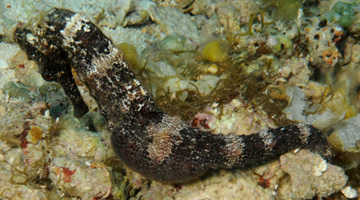While seahorses certainly are a unique-looking fish, that’s hardly their most unusual trait. Seahorses and their relatives, pipefishes, are the only family of fish in which the males become pregnant and give birth.
The process begins with males seeking out the largest females, who provide the largest size and greatest number of eggs. The pair swim together, “hold tails” and “dance” for several mornings. Then, an 8-hour courtship dance leads to the actual mating. A pregnant male seahorse in Cozumel, Mexico. Credit: Steve Herrick
A pregnant male seahorse in Cozumel, Mexico. Credit: Steve HerrickNose to nose, the seahorses spin around each other while the male puffs up a pouch on his belly. The female then uses a tube, called an ovipositor, to insert a half dozen to over a thousand eggs in his pouch. The male fertilizes them, and then his pouch — like a placenta — circulates blood to the embryos to provide them nutrients, oxygen, and the appropriate salt concentration for development.
Birth happens much the same way it does in many animal species: dad breathes faster, becomes paler and has contractions which culminate in releasing fully formed tiny seahorses. But then dad’s job is done — there is no cuddling or child rearing. Only about 5 in 1000 of the tiny seahorses will reach adulthood because extreme temperatures, ocean currents and predators all work against them.
But there is no rest for the weary. Mom returns to visit and, often, dad is pregnant again the next day. Most seahorses are monogamous each breeding season, and multiple pregnancies ensure better survival rates. Scientists aren’t entirely sure why the males give birth, though some suspect it’s to spread out the energy required for reproduction, giving females time to prepare more eggs during the male’s pregnancy. But one thing is clear — these guys really do the dirty work in reproduction!


